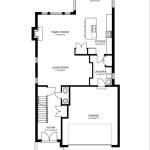How to Draw Your Own House Floor Plans
Whether you're an experienced home builder or a first-time homeowner, being able to draw your own house floor plans can be a valuable skill. Not only will it help you communicate your ideas to contractors and architects, but it can also help you save money by avoiding costly mistakes. ### Materials You'll Need * Graph paper * Pencil * Eraser * Ruler * Compass * Stencils (optional) ### Step-by-Step Instructions 1.Choose a Scale
The first step is to choose a scale for your floor plan. This will determine how detailed your plan will be. A common scale for residential floor plans is 1/4 inch = 1 foot. This means that every 1/4 inch on your plan will represent 1 foot of real space. 2.Draw a Basic Outline of Your House
Start by drawing a rectangle to represent the perimeter of your house. The length and width of the rectangle should be based on the dimensions of your lot. 3.Add the Main Rooms
Next, start adding the main rooms of your house to the floor plan. These typically include the living room, dining room, kitchen, bedrooms, and bathrooms. 4.Draw the Walls
Once you have the main rooms laid out, you can start drawing the walls. The thickness of the walls will depend on the type of construction you're planning. 5.Add Windows and Doors
Next, add the windows and doors to your floor plan. Be sure to indicate the swing direction of the doors. 6.Draw the Stairs
If your house has stairs, add them to the floor plan. Be sure to indicate the number of risers and treads. 7.Add the Fixtures
Finally, add the fixtures to your floor plan. These include things like sinks, toilets, showers, cabinets, and appliances. ### Tips for Drawing House Floor Plans *Be accurate.
The more accurate your floor plan is, the better it will be for communicating your ideas to contractors and architects. *Use a consistent scale.
Make sure to use the same scale throughout your floor plan. Otherwise, it will be difficult to interpret. *Label the rooms.
Write the name of each room next to it on the floor plan. This will help you keep track of what room is what. *Use symbols.
There are a number of standard symbols that are used in floor plans. These symbols can help you communicate your ideas more clearly. *Get feedback.
Once you've finished drawing your floor plan, get feedback from friends, family, or a professional. This can help you identify any errors or areas for improvement. ### Conclusion Drawing your own house floor plans can be a fun and rewarding experience. By following the steps and tips outlined in this article, you can create a floor plan that is both accurate and informative.
Make Your Own Blueprint How To Draw Floor Plans

Make Your Own Blueprint How To Draw Floor Plans Drawing House Sketch Plan Blueprints

Create Floor Plan

House Plans How To Design Your Home Plan

Floor Plans Learn How To Design And Plan

House Plans How To Design Your Home Plan

House Plans How To Design Your Home Plan

How To Draw A Floor Plan The Simple 7 Step Guide For 2024

Design Your Own Home House Designing Homes

House Plans How To Design Your Home Plan








